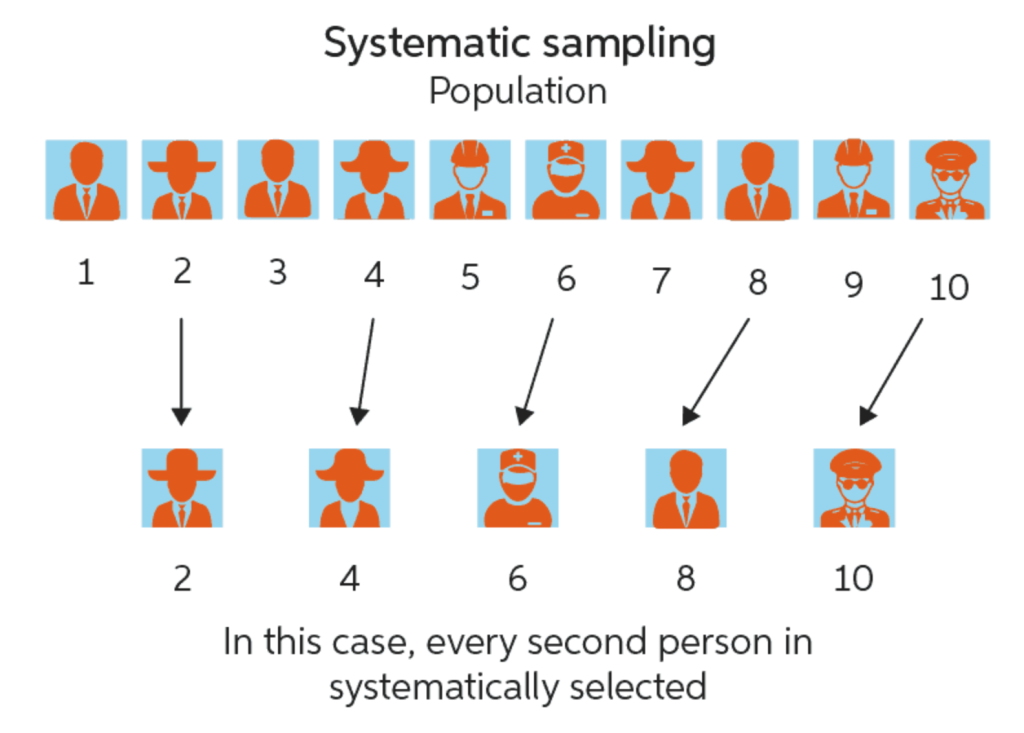
As a researcher, you should always ensure that your sample accurately reflects the population. Systematic random sampling is among the best options for sampling efficiency.
It allows researchers to obtain a representative sample from a large population without a complete list of the population. This article will cover everything about systematic sampling, including its definition, benefits, and drawbacks.
What is Systematic Random Sampling?
Systematic random sampling is a statistical method in which the researcher selects every ‘n’ th element from the population to create a sample. By utilizing this form of probability sampling, every component of the population has an equal chance of being a sample.

How Does Systematic Sampling Work?
To conduct systematic sampling, the researcher must first define the population they want to study. The population can be any group of individuals, objects, or events with similar characteristics.
Next, the researcher must determine the sample size and the number of elements they want to include. The sample will be more representative of the population if it is larger in size.
After determining the sample size, the researcher must calculate the sampling interval by dividing the population by the sample size. For example, if the population size is 1,000 and the sample size is 100, the sampling interval would be 10.
The researcher then picks a random position within the population from which to collect samples, using the sampling interval as a guide. Generally, you can do so by using a random number generator or selecting a number randomly.
Finally, the researcher selects every nth element from the population to create the sample. For example, if the sampling interval is 10, the researcher would select every 10th element from the population until they obtain the required sample size.
ALSO READ: Representative Samples: Importance + Methods Advantages of Systematic Random Sampling
- Easy to understand and implement.
- Ensures that a representative sample is from a large population.
- Less time-consuming compared to other sampling methods.
- The selection of every population component has an equal opportunity as the sample reduces the likelihood of a bias.
Overall, systematic random sampling is a reliable and efficient technique for sampling a population.
Disadvantages of Systematic Sampling
- It may not be appropriate for populations with a non-random order.
- Introduces a systematic bias if a population pattern is related to the sampling interval.
- This results in a less diverse sample if there is a pattern in the population related to the sampling interval.
Of course, it’s important to note that not all of these disadvantages will apply in every situation. However, it’s always a good idea to be aware of the potential limitations and to carefully consider whether it’s the best choice for a given research project.
ALSO READ: The Difference Between Sample Bias And Sampling Error How to Conduct Systematic Random Sampling
Here are the steps to conduct systematic random sampling:
Step 1: Define the Population
The first step in conducting systematic random sampling is to define the population you want to study. We should clearly define the population, which includes all individuals, objects, or events with similar characteristics.
Step 2: Determine the Sample Size
Next step is to determine the sample size. The sample size must be sufficient to ensure representativeness while also being manageable. Hence, the sample size can be determined using statistical formulas or a sample size calculator.
Step 3: Calculate the Sampling Interval
Once the sample size is determined, the next step is to calculate the sampling interval. We skip a certain number of elements in the population before selecting the next element for the sample. This number is called the sampling interval. The formula to calculate the sampling interval is:
Sampling Interval = Population Size / Sample Size
For instance, if the population size is 2500 and the sample size is 50, then the sampling interval would be:
Sampling Interval = 2500 / 50 = 50
This means we will select every 50th element in the population for the sample.
Step 4: Choose a Random Start
The next step is to choose a random start. It is essential to do this to ensure we do not bias the sample towards a particular group and accurately represent the entire population.
Overall, this ensures that we do not keep the biases of the sample towards one specific group and accurately represent the whole population.
You can achieve a random start by using a random number generator or selecting a starting point randomly.
Step 5: Select the Sample
Finally, we can select the sample by choosing every nth element from the population, where n represents the sampling interval. You can select these elements as the sample for the study.
ALSO READ: Survey Data Collection: How to Get the Best Results? Conclusion
To sum up, systematic random sampling is the most reliable method for obtaining a sample that accurately reflects a big population. By using it, we can implement the process while reducing bias by giving all elements of the population an equal chance of being selected for the sample.
However, it may not be appropriate for populations with a non-random order. It may introduce systematic bias if there is a pattern in the population related to the sampling interval.
Researchers can confidently conduct systematic random sampling and produce a representative sample using the procedures described in this article.
FAQs
- What distinguishes simple random sampling from systematic random sampling?
Simple random sampling involves selecting elements from a population at random. In contrast, systematic sampling involves selecting every nth element from the population.
- Can systematic sampling be used for small populations?
It’s possible that random sampling won’t be as reliable for small populations as other methods.
- What makes systematic random sampling superior to other sampling techniques?
Systematic random sampling is less time-consuming than other methods and ensures a representative sample from a large population.
- Is systematic random sampling suitable for qualitative research?
Yes, systematic sampling is used for qualitative research. Still, it may only be appropriate for some types of qualitative research.
- What is the recommended sample size for systematic sampling?
The recommended sample size for systematic random sampling depends on the population size and the level of precision required. A larger sample size will provide greater accuracy, but it may only be feasible or necessary for some studies.
Not Sure Where To Begin?
Explore our solutions to discover what is most important to your customers,
clients, and prospects. And best of all – it doesn’t take any coding!
Free Trial • No Payment Details Required • Cancel Anytime




